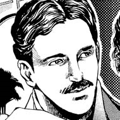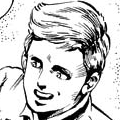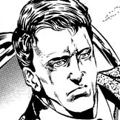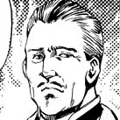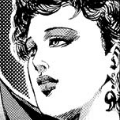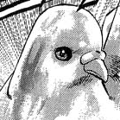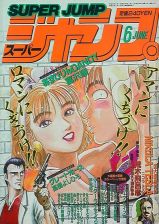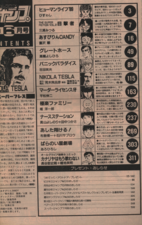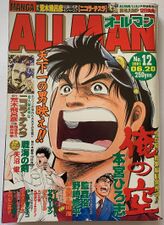The Lives of Eccentrics - Episode 1
The Genius Who Made Edison Cower: Nikola Tesla (エジソンを震えあがらせた大天才『ニコラ・テスラ』, Ejison o Furueagaraseta Daitensai "Nikora Tesura") is the first episode of The Lives of Eccentrics series, written by Hirohiko Araki and illustrated by Hirohisa Onikubo with assistance from Nobuyuki Fujii. It was originally released in the June 1989 issue of Super Jump, and was later reprinted in issue 12 of Manga Allman on June 6, 2001.[1]
In the volumization, this chapter serves as the sixth and final chapter of the series.
Summary
The following is a true story about an individual who really existed.
The year is 1898. In the city of New York, Nikola Tesla demonstrates his latest experiment to members of the local press: a machine capable of splitting a huge steel block in half via creating and directing a countless number of small vibrations at it. The experiment is not only successful, but more powerful than expected, causing the surrounding buildings to tremble as they would in an earthquake. No records of the machine or the man who invented it exist today, apart from one calm and intellectual statement the man left in a local newspaper.
Nikola Tesla was born in Yugoslavia, and demonstrated a knack for invention in his youth. Unfortunately for him, Tesla also harbored a deep-seated fear of round trinkets, which his fellow youths exploited to torment him. On the other hand, Tesla adored sharp objects, and would even chase after bolts of lightning in the night sky. Tesla was 23 when he saw a light bulb for the first time, and was instantly awestruck at both the lightbulb and its inventor, one Thomas Edison. Five years later, after immigrating to the United States, Tesla managed to gain a staff position in the Edison Company ran by the very man he idolized.
Edison, four years Tesla's senior, asked Tesla to fix a set of broken generators as his first task, expecting him to finish after at least two weeks. Fortunately, or perhaps unfortunately, Tesla had the ability to not only build a machine from its diagram, but to construct a diagram from a finished machine. After merely six hours, Tesla finished his task, earning not Edison's praise but his resentment. While Edison would work tirelessly on a problem, making mistake after mistake on the road to success, Tesla had the talent to solve the same problem almost instantly. When Tesla dared to design a motor running on alternating current electricity, which stood in contrast to Edison's own direct current electricity, the older inventor furiously asked the younger to give up on his invention. When Tesla stood firm, Edison intimidated Tesla with a cue ball and fired him on the spot.
From that day onward, Tesla lived in poverty. He also found himself unable to work anywhere, as his former employer had spread derogatory rumors about him. As Edison proudly demonstrated the dangers of alternating current via the electric chair and animal electrocution, Tesla lived in utter fear. One day, however, a man named Westinghouse approached Tesla and offered to fund his research into alternating current, on the condition that he surrender any patents on the technology to Westinghouse's own company. Tesla, desperate for revenge against Edison, reluctantly agreed to Westinghouse's conditions.
At the World's Columbian Exposition in 1893, Tesla returned to the public eye, to the shock of Edison and his company. Not only was the convention illuminated by Tesla's own lighting systems, but Tesla himself calmly sat in a chair surrounded by sparks of alternating current electricity. To demonstrate alternating current's ability to have its voltage adjusted, Tesla overcomes his own fear to produce balls of pure electricity, which fly over his enraptured audience. Soon afterward, a hydro-electric generator was built atop Niagara Falls, powered by Tesla's alternating current. Tesla had unilaterally defeated Edison. Yet when the Nobel Peace Prize was awarded to both Tesla and Edison, both turned down the award out of sheer disgust toward each other.
Despite his victory, Tesla's idiosyncrasies only increased in intensity. Tesla insisted on shining his plates and utensils with exactly 18 napkins before any meal, and further measuring each dish before enjoying it. Tesla's new inventions, too, became cruel and esoteric. Once, Tesla and a woman named Anne Morgan began dating, only for Tesla to break off the relationship when she wore pearl earrings to a date. And so, Tesla stayed single for his entire life.
And yet, Tesla had something he loved on the same level as any potential romance: a white pigeon whose wing he had once treated. Whenever Tesla whistled for her, he and the pigeon would find each other, no matter what park or crowd Tesla was in. One night, the pigeon visited Tesla in his room much later than usual. Tesla comforted the bird, only to find that it had come to say goodbye to him before it passed away. At that moment, Tesla knew his life had come to an end.
One year after the pigeon's death, Tesla's maid found him laying dead in his bed, looking as peaceful as if he were only sleeping. All of the late genius's drafts, blueprints, and test models were confiscated by the FBI after his death, and his legacy disappeared with them into the darkness of history.
Appearances
Author's Comment
This is our debut work. Please tell us your thoughts about it. —Hirohisa Onikubo/Nobuyuki Fujii
僕たちのデビュー作です。感想聞かせて下さい。 <鬼・藤>
Gallery
Trivia
- In real-life, Edison didn't fire Tesla: instead, Tesla left the company on his own terms after Edison backtracked on his promise to reward Tesla for redesigning Edison's inefficient motors and generators. The real Nikola Tesla also hailed from Croatia rather than Yugoslavia.
- Edison and Tesla's double Nobel nomination may never have occurred. However, Tesla was indeed one of the candidates for the 1915 Nobel prize.
References
- Nikola Tesla on Wikipedia
- Thomas Edison on Wikipedia
